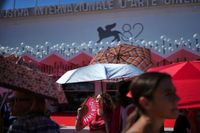The curtain has fallen on the 82nd Venice International Film Festival, closing out ten days of cinematic spectacle, star-studded red carpets, and a dazzling array of global talent. As the Lido returned to its tranquil rhythm, the festival left behind a trail of unforgettable moments, record-breaking ovations, and a few surprising twists—both inside the theaters and out on the streets.
This year’s festival, which ran from late August through September 7, 2025, was nothing short of a whirlwind, drawing filmmakers, actors, and movie lovers from 65 countries. According to the Associated Press, a staggering 4,580 films were submitted for consideration, with 1,936 of those being feature-length. Each feature submission came with a hefty 200 euro ($234) price tag, and only 21 features made it into the coveted main competition. That’s a selection rate of just over 1%—a testament to the festival’s fierce standards and global prestige.
The top prize, the illustrious Golden Lion, was awarded to American director Jim Jarmusch for his film Father Mother Sister Brother. As reported by Lexus, who served as the festival’s Sponsor and Official Car, the jury—led by acclaimed American director Alexander Payne—bestowed the Golden Lion upon Jarmusch’s work, solidifying his place among cinema’s elite. The main competition jury also included an international mix of filmmakers and actors: French director Stéphane Brizé, Italian director Maura Delpero, Romanian director Cristian Mungiu, Iranian director Mohammad Rasoulof, Brazilian actor Fernanda Torres, and Chinese actor Zhao Tao.
But the festival’s story wasn’t just told in awards and premieres. The numbers themselves painted a vivid picture: 30 films made their world premieres out of competition, while 19 competed in the Horizons sidebar and 18 classic restorations graced the Venice Classics section. Films from every corner of the globe—from Ecuador to Taipei—found their place on the Lido’s screens, reflecting the festival’s enduring commitment to international diversity since its founding in 1932.
Red carpet arrivals were as glamorous as ever, thanks in part to Lexus, who provided a fleet of 30 electrified luxury vehicles—including the compact UX, the NX and RX SUVs, and the all-electric RZ crossover—to chauffeur filmmakers, actors, and VIP guests between events. The festival also offered a sneak peek at the all-new Lexus ES flagship sedan, described by Lexus as embodying “exceptional attention to detail, precision craftsmanship and the application of advanced technologies for performance, safety, connectivity and comfort.”
Paolo Moroni, Director of Lexus Italy, reflected on the brand’s partnership with the festival, stating, “This is also the end of an extraordinary event for Lexus. Every year, Venice Film Week produces the kind of unique emotions that we want to give to customers when they experience our brand. We are proud to have taken part in this prestigious international event and to have accompanied its most illustrious guests to the red carpet. It was also an exceptional opportunity for us to present a preview of our new flagship ES and share our concept of mobility based on ‘Making Luxury Personal,’ with personalised details that anticipate customers’ needs and preferences and create an even more exciting and rewarding driving experience.”
Innovation wasn’t limited to the cars or the films themselves. This year’s Venice Film Week included the Reply AI Film Festival, a competition dedicated to short films created using Artificial Intelligence tools. The highlight was the Lexus Visionary Award, presented by Paolo Moroni to Marcello Costa Jr. for his short film “Instinct.” Lexus emphasized its commitment to promoting innovation as a means of fostering authentic emotions and deeper connections, both in cinema and on the road.
As the festival unfolded, the city of Venice played host to more than just cinematic celebrations. On August 30, an estimated 10,000 people participated in a Gaza anti-war march, according to the Associated Press. The conflict in Gaza reverberated through the festival, sparking high-profile debates and calls to disinvite certain celebrities, including Gerard Butler and Gal Gadot, over their perceived ties to the Israeli military. The march shifted some of the festival’s spotlight from glitz to global crisis, underscoring the power of art—and protest—to provoke discussion and reflection.
Inside the theaters, emotions ran high. Kaouther Ben Hania’s The Voice of Hind Rajab shattered previous records for standing ovations, with applause lasting between 22 and 23 minutes. The film, which uses real audio from a Palestinian girl’s desperate call for rescue in Gaza, struck a deep chord with audiences. It was, as Variety and BBC reported, the longest ovation in festival history, surpassing even last year’s winner.
The festival also honored two giants of cinema with lifetime achievement Golden Lions: Kim Novak, the legendary 92-year-old star of Hitchcock’s Vertigo, and Werner Herzog, the prolific German filmmaker known for both his documentaries and his forays into acting. Francis Ford Coppola, himself a recipient of the award in 1992, was on hand to present Herzog’s honor and to attend the premiere of MEGADOC, a documentary about the making of his film Megalopolis. Sofia Coppola, his daughter, also had a film in the lineup, further cementing the Coppola family’s enduring influence on the festival.
Practical details added another layer to the festival’s allure. The historic Sala Grande theater, with its 1,032 seats and additional wheelchair spaces, hosted the biggest screenings and award ceremonies. Getting around Venice was an event in itself: the Palazzo del Cinema sits 4.5 kilometers from the iconic Piazza San Marco, a journey of 32 minutes by vaporetto, the city’s public water bus. For those with deep pockets, a night at the Belmond Hotel Cipriani—favored by stars like George Clooney and Julia Roberts—could set you back $5,370. Even the cocktails had a story: the Buonanotte, a “fresh, fruity, low alcohol” creation, cost 34 euros, while the classic Campari spritz followed a 2:3:1 ratio of Campari to prosecco to soda water, a staple for festival-goers at just 4 euros a glass.
Subtitles, too, were a matter of precision: all non-Italian-language films required Italian subtitles, and Italian-language films needed English subtitles, with preferred specifications of Arial font, size 44, and white text burned onto the screen. It’s a testament to the festival’s attention to detail—every film, every moment, meticulously crafted for an international audience.
As the 82nd Venice International Film Festival fades into memory, what lingers is not just the glitter or the glamour, but the sense of global community, creativity, and conscience that defined this year’s edition. Whether through the roar of applause, the hum of electric vehicles, or the chants of protestors, Venice once again proved itself a stage where art and life intersect in remarkable and unpredictable ways.

